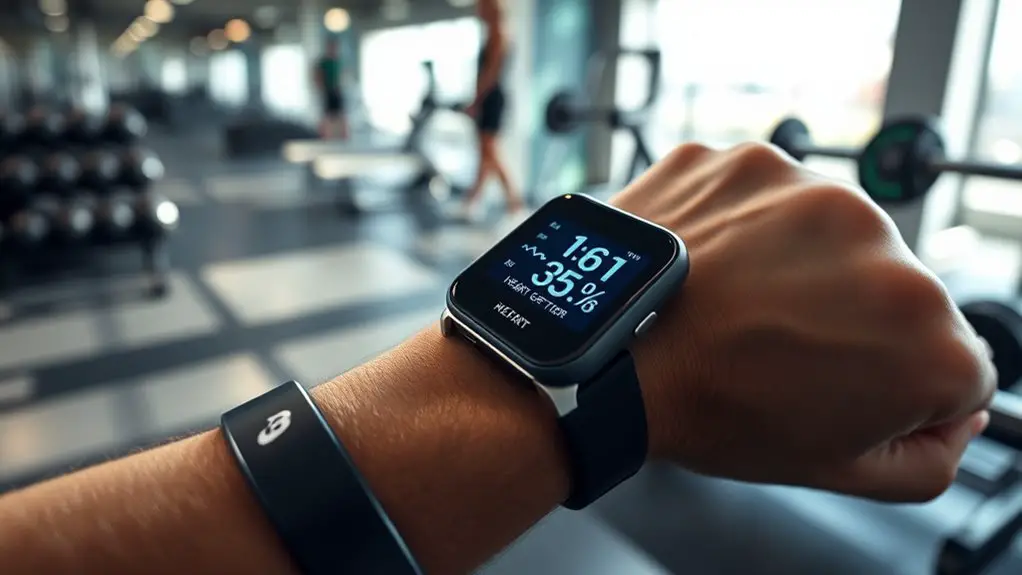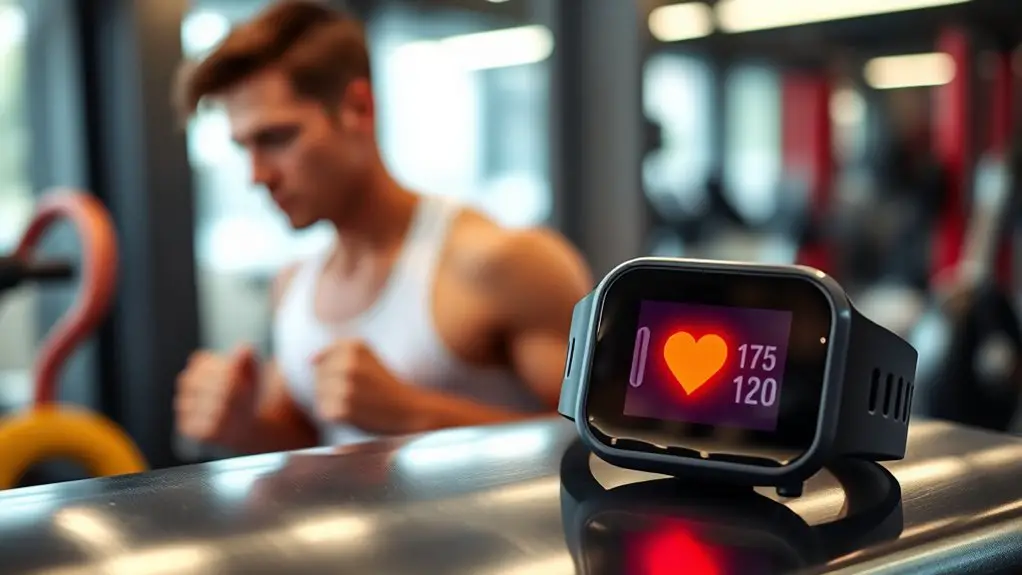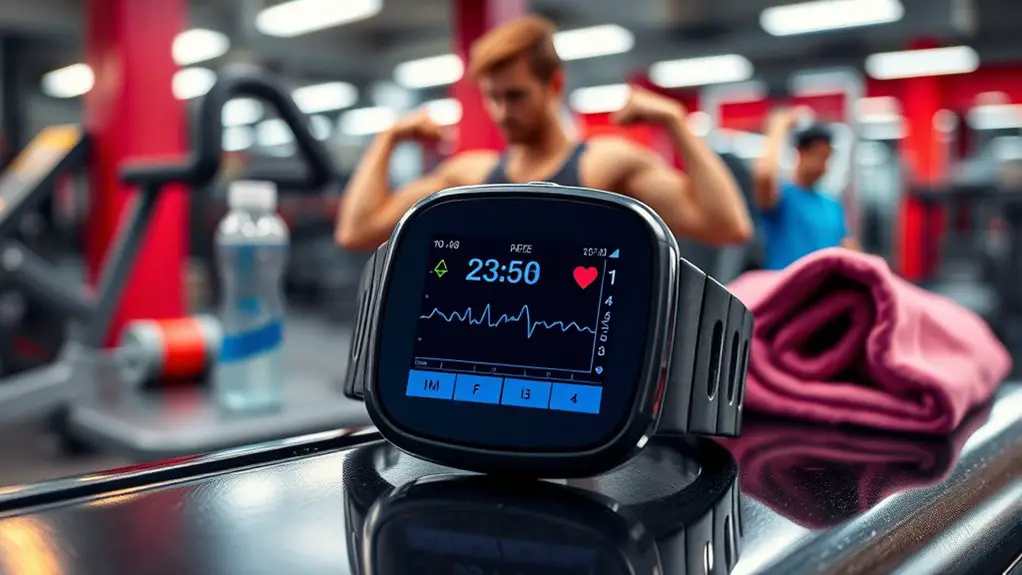How to Use a Heart Rate Monitor for Gym Training

To use a heart rate monitor effectively during gym training, wear it correctly and sync it with your smartphone for data analysis. Set your personal heart rate zones based on your fitness level. Monitor your heart rate throughout the workout to adjust intensity and stay in your target zone. Post-workout, review the data to assess performance and make adjustments. There’s more to optimizing your training that can help you reach your goals faster.
Understanding Heart Rate Monitors

Heart rate monitors are essential tools for anyone serious about their gym training. These devices help you keep track of your heart rate, ensuring you stay within a safe range while pushing your limits. With the rise of wearable technology, you’ve got various options, from wristbands to chest straps, each designed to provide accurate readings. Understanding your heart rate variability is vital; it can indicate how well your body is recovering and whether you’re overtraining. Monitoring these metrics not only helps optimize your workout but also enhances your safety. By paying attention to how your heart responds to exercise, you can adjust your intensity to avoid potential health risks. Remember, it’s not just about pushing harder—it’s about training smart. So, invest in a reliable heart rate monitor and make it an integral part of your fitness routine. Your heart will thank you for it!
Benefits of Tracking Heart Rate
Tracking your heart rate can greatly enhance your workout experience by providing valuable insights into your fitness levels and performance. The heart rate benefits are significant; by monitoring your pulse, you can guarantee you’re exercising within your target zone, which promotes safety and maximizes effectiveness. This means you’re less likely to overexert yourself or risk injury.
Additionally, the tracking advantages help you tailor your workouts. You can easily identify when to push harder or when to recover, leading to improved endurance and strength over time. Monitoring your heart rate also assists in setting realistic fitness goals, giving you a clearer picture of your progress.
Ultimately, keeping an eye on your heart rate not only helps you achieve your fitness ambitions but also fosters a safer workout environment. Embracing heart rate monitoring is a smart move for anyone looking to optimize their gym training.
How to Choose the Right Heart Rate Monitor

When selecting the right heart rate monitor, it’s important to contemplate your specific fitness goals and preferences. This choice can greatly impact your training efficiency and safety. Consider the following factors to guide your decision:
- Type of Monitor: Chest strap vs. wrist-based options
- Heart Rate Zones: Features for tracking intensity levels
- Connectivity: Bluetooth or ANT+ compatibility for syncing with apps
- Battery Life: Duration to avoid interruptions during workouts
- Price Range: Budget considerations to guarantee you find value
Conduct a features comparison between options to see which aligns with your needs. Remember, investing in a reliable heart rate monitor is essential for monitoring your health and optimizing your workouts, ultimately enhancing your fitness journey while keeping safety in mind.
Setting Up Your Heart Rate Monitor
After choosing the right heart rate monitor, the next step is getting it set up properly. Start by checking the device compatibility with your smartphone or gym equipment to guarantee seamless data transfer. Once connected, follow the manufacturer’s instructions for calibration techniques. This often involves inputting your age, weight, and fitness level, which helps the monitor provide accurate readings.
You might also want to familiarize yourself with any customizable settings, like alerts for high or low heart rates, as these can enhance your safety during workouts. Before your first workout, take a few minutes to test the monitor and verify it’s functioning correctly. If you experience any issues or inaccuracies, refer to the calibration techniques again, as a proper setup is vital for monitoring your heart rate effectively. This way, you can feel confident and secure while pushing your limits in the gym.
Identifying Your Heart Rate Zones

To maximize your workouts, understanding your heart rate zones is essential. These zones help you train effectively and safely, ensuring you’re not overexerting yourself. Here’s what to know about identifying your heart rate zones through zone training:
- Resting Zone: Your heart rate at rest; this is your baseline.
- Fat-Burning Zone: Low to moderate intensity; great for burning fat and improving heart rate variability.
- Aerobic Zone: Moderate to high intensity; builds endurance and cardiovascular strength.
- Anaerobic Zone: High intensity; enhances performance and builds muscle.
- Maximal Zone: Very high intensity; used in short bursts for peak performance training.
How to Use Heart Rate Data During Workouts
Using heart rate data during your workouts can greatly enhance your training effectiveness, as it allows you to stay within your desired heart rate zones. Monitor your heart rate variability to gauge how well your body is responding to training. If you notice significant fluctuations, it might indicate that your body needs more recovery time.
Pay attention to the recovery importance; taking adequate rest can lead to better performance in future workouts. If you find your heart rate climbing too high, it’s a signal to ease up and avoid overexertion, which can lead to injuries or burnout.
Conversely, if your heart rate remains too low, you might need to increase the intensity to achieve your fitness goals. By regularly checking your heart rate, you can make informed decisions during your workouts, ensuring you’re training safely and effectively.
Tips for Staying in Your Target Heart Rate Zone
To maximize your workout effectiveness, it’s essential to calculate your target heart rate zone before you start. During your sessions, keep an eye on your heart rate monitor to guarantee you’re staying within that zone. This way, you’ll optimize your training and reach your fitness goals more efficiently.
Calculate Your Target Zone
Finding your target heart rate zone is essential for effective gym training, and it can help you maximize your workouts. To guarantee you’re calculating fitness accurately and monitoring intensity, follow these steps:
- Calculate your maximum heart rate by subtracting your age from 220.
- Determine your target heart rate zone, typically 50-85% of your maximum.
- Use your heart rate monitor to track your beats per minute during workouts.
- Adjust your workout intensity based on your heart rate readings.
- Make certain to listen to your body, taking breaks if you feel dizzy or overly fatigued.
Monitor During Workouts
Keeping an eye on your heart rate during workouts is essential for staying within your target zone and maximizing your training benefits. To guarantee safety, regularly check your heart rate to gauge your workout intensity. If you’re nearing the upper limit of your target zone, consider lowering your pace to avoid overexertion. Remember, pushing too hard can lead to injuries or fatigue. Use your heart rate monitor to track performance metrics, helping you identify when to increase or decrease effort. Incorporate brief rest periods if you find your heart rate consistently high. This approach not only enhances your training efficiency but also helps maintain your overall well-being while achieving your fitness goals. Stay mindful, and enjoy your workouts!
Monitoring Progress and Adjusting Your Training
As you progress in your gym training, using a heart rate monitor can provide invaluable insights into your performance and help you tailor your workouts. By focusing on progress tracking, you can make informed training adjustments that guarantee safety and effectiveness.
Consider the following strategies:
- Set specific heart rate zones to optimize your workouts.
- Monitor recovery times to guarantee you’re not overtraining.
- Track trends over time to see improvements or plateaus.
- Adjust intensity based on your heart rate, guaranteeing you stay within safe limits.
- Use data to motivate yourself and make training more engaging.
Frequently Asked Questions
Can Heart Rate Monitors Be Used for Outdoor Activities as Well?
Absolutely, heart rate monitors can be your compass during outdoor workouts. Just like a lighthouse guiding ships, these devices provide essential heart rate tracking, ensuring you stay on course for your fitness goals. Whether you’re hiking, running, or cycling, they help you gauge your intensity and keep your heart safe. So, strap one on, embrace the fresh air, and let it lead you to a healthier, more informed outdoor experience.
How Do I Clean and Maintain My Heart Rate Monitor?
To clean and maintain your heart rate monitor, start with basic cleaning techniques. Wipe down the device with a soft, damp cloth after each use to remove sweat and dirt. For the straps, hand wash them with mild soap and water to prevent bacteria buildup. Always let it dry completely before storing. Regular maintenance tips include checking the battery and ensuring the device is properly calibrated, ensuring your monitor stays safe and effective.
Are There Any Side Effects of Using a Heart Rate Monitor?
Using a heart rate monitor can have some side effects, though they’re generally minimal. You might experience accuracy concerns, especially if the device isn’t fitted correctly or worn properly. Some users also report discomfort if the strap is too tight or made of irritating materials. It’s important to choose a comfortable device that fits well to avoid any potential issues. Always listen to your body and consult a professional if you notice any adverse effects.
Can Heart Rate Monitors Be Synced With Fitness Apps?
Sure, syncing your heart rate monitor with fitness apps is super simple! Most modern monitors boast fantastic fitness app compatibility, allowing you to track your heart health seamlessly. You’ll find various syncing options, whether via Bluetooth or Wi-Fi, ensuring your workout data’s safely stored and easily accessible. Keeping your heart rate monitored while exercising not only enhances your performance but also helps you prioritize your safety and well-being. So, go ahead and connect!
What Should I Do if My Heart Rate Monitor Malfunctions?
If your heart rate monitor malfunctions, don’t panic. Start with some troubleshooting tips, like checking the battery and ensuring it’s properly secured. Common issues often stem from poor connectivity or skin contact; make sure the sensors are clean and snug against your skin. If problems persist, consult the user manual or the manufacturer’s website for specific solutions. Prioritize your safety and consider using a backup method to monitor your heart rate in the meantime.





